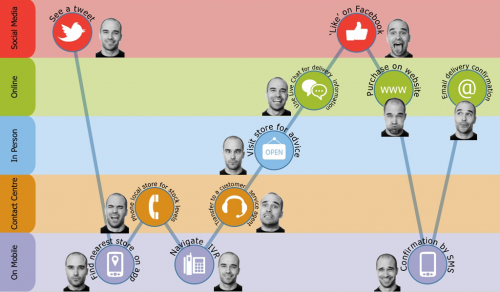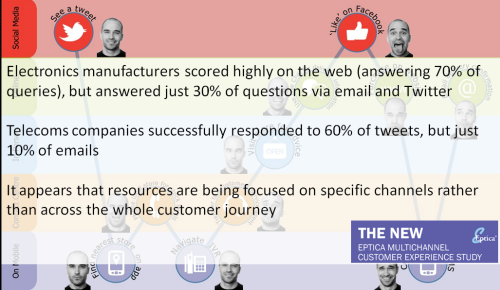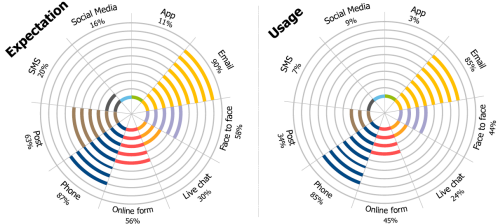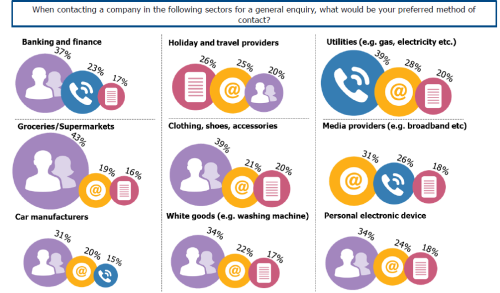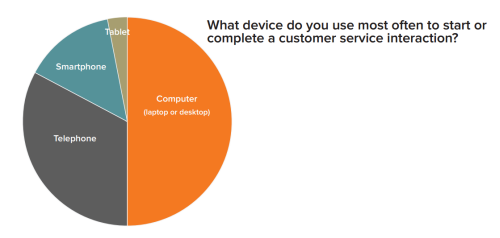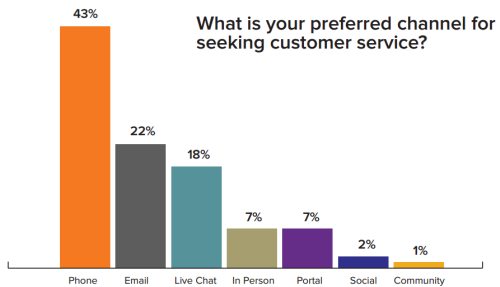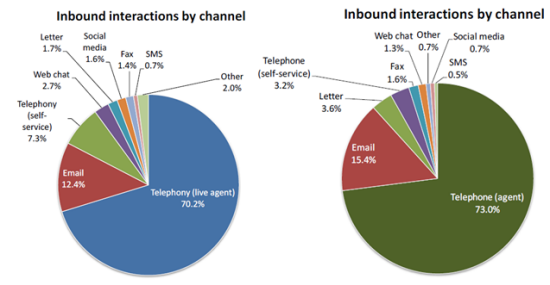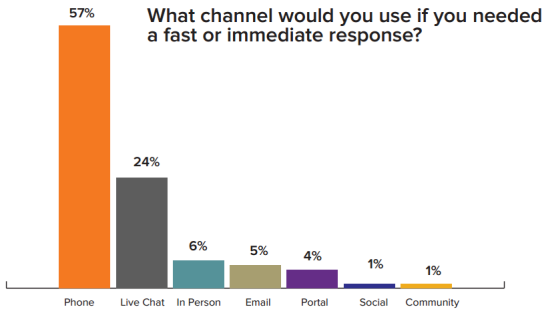
There is currently much focus on multi-channel experience. Technologists frame the challenge as a move from multi-channel to cross channel. Those in retail talk about the need for omni-channel competency. Meanwhile the customer experience profession discuss customer journey mapping while service organisations ponder the value of ‘customer effort’ as a new way to understand the ‘outside-in’ experience of doing business with them.
Of course all this is based on a sea change in customer behaviour. Let’s call it ‘becoming digital’ for the sake of discussion. Or as someone put it so well in a recent discussion on a Linkedin group:
“The term “digital” is simply recognising how the customer has changed. We’re all digital people – social, mobile, always on, connected, online, etc. Our means of communicating with each other has evolved as the digital age has caught on.
This has given rise to a game changing leap in terms of expectations around convenience, choice, reliability and speed that few organisations have got close to mastering. In theory this revolves around an equally trusted channel mix. However as each new survey continues to confirm, live voice remains the default channel despite growing consumer frustrations with it.
So if there is so much momentum towards something new, why the hold up?
Eptica’s 2014 Multichannel Customer Experience Study summarises present day competency of UK organisations perfectly by observing:
The Instinct For Control Creates Fragmentation
Their insight around ‘discrepancies in performance’ is in many ways the central challenge of delivering successful multi-channel experiences. Put another way, the average customer journey is likely to be experienced as ‘lumpy’ more often than not.
That old root cause of silos and non aligned priorities around service standards is still to blame. One team might excel while another does not. One is fully resourced and trained. Another is not.
This is because we are yet to operate as organisations around a common view of what customers expect and experience. All the evidence suggests that individual channels matter more than overall brand consistency. In other words, a channel owner is still more preoccupied with their own agenda than that of their colleagues.
In fact, the larger an organisation, the more fragmented its approach to channels can become. Its need for control takes over. Thus some channels are managed in house, others with outsourcers. Some are owned by Customer Service, some with Marketing or e-commerce. It’s often a generational thing. E-service is separate from the contact centre delivered service despite the fact we know a steady flow of inbound originates from online failures.
An even more contemporary fragmentation is happening in social customer service. The management of peer to peer support is normally separate from the Twitter and Facebook teams. I even know of two organisations that have social customer service reporting into web chat which itself is an island unto itself!
These examples reflect a mindset problem that needs urgent attention if new behaviour and capability is ever going to break out.
Consider this. It is common knowledge that customers use a wide range of engagement channels. Therefore from a brand perspective, is it not pure negligence if those channel owners are not spending time in workshops figuring out how to deliver more consistent service between them?
Of course they could argue that it is all on the roadmap. Certainly integrated infrastructures are going to be part of any ongoing competency. But meanwhile there is much that can be achieved through internal collaboration and a willingness to think ‘outside-in’.
A topic that should be top of this common agenda is consistency. Here is a classic example. Later in the same report, Eptica show how service organisations clearly need to revise their mindset around channel mix. The current decision seems to be that excellence in just one channel will do. While the research does not attempt to identify why this is happening, my guess is that ‘inside-out’ thinking still believes it can dictate what works for customers.
Starting to tackle these types of multi-channel anomalies takes organisations to the very heart of the debate. For years, service organisations have had to juggle with two prime aims: reducing costs while improving customer experience. Customer feedback tells us which of those won most often.
Isn’t the Eptica research simply reflecting this tension? Pragmatically, service leaders have had to choose where they invested in excellence. Clearly being good at one or two channels is more affordable than trying to be good at them all.
However the changes in customer expectation that we all now acknowledge has blown a hole in this logic. Cost containment cannot remain the prime driver. If you believe that the quality of service does indeed drive your customer behaviour for better and worse, then the balance between traditional ‘inside-out’ and fashionable ‘outside-in’ is now a defining decision for you as a service leader. Getting it wrong can be as disastrous as a CFO making a mess of the accounts.
Who Determines Excellence – You Or Your Customers?
Part of the problem is a belief organisations still cling onto that they know best as far the channel mix is concerned. Of course social customer service is leading the charge to prove this is no longer the case and that organisations need to prioritise the customers’ choice.
But the instinct remains strong. Quoting from another section of the Eptica report, we can see how internal priorities drive certain channel choices that fly in the face of actual consumer demand.
Email is more often than not their second most popular channel after live voice. The headline statistic around the outside-in perspective is this. 58% of customers want to communicate with companies by email, rising to 69% for Generation Z. The fact that greater demand is seen in the youngest demographic also challenges the view that email is becoming a legacy channel any time soon.
Yet despite this evidence, there is a clear trend towards restricting its availability and stunting its performance.
All that can be asked is what logic drives this? Whose priority is being served? Indeed does anyone actually know what commercial consequences flow from this? Unsurprisingly Eptica’s conclusion is that organisations are pushing away new business as a result.
So how do we all recover from this fractured, cost containment mindset that has ruled decision making for too long?
The first step to recovery is to acknowledge a simple truth. In reality ‘channels multiply, they seldom die’. The cost of being a customer experience business today means you have to learn the full cross channel dance.
In a UK study from eDigitalResearch (Customer Service Benchmark Wave One November 2013), we can see how important it is to see choice itself as an important aspect of the service offering. Expectations might always exceed usage, but choice is a signal to customers that you care.
In fact Helen Burt, Customer Experience Operations Manager at eDigitalResearch, offered this great insight on the importance of choice as she participated in the webinar that preceded this post.
“We’ve found that in some circumstances and projects the customer journey is so complex that actually attempting to map journeys is too labour intensive and not that useful. The important thing is to ensure that all channels are available and working well, but perhaps prioritise those channels which are most appropriate for each type of journey.”
If customer behaviour is indeed too complex to map then consider the following analysis; also included in the eDigitalResearch study. It shows channel choice and use is a function of the type of situation and activity customers find themselves in.
This means talking about channel preferences makes best sense in the context of the type of organisation you are and the tasks that customers undertake with you. So if we conclude that customers are driving the agenda on channel choice how do we practically implement this design principle?
One way of mapping channel preferences is to ask customers! Do this whenever you are on-boarding a new customers or at a significant point of regenerating the relationship such as annual renewals. Once this information is captured in your CRM, it can be used as a business rule to use the preferred channel of choice.
It is much smarter to ask than to guess. For instance this is the view of another webinar participant. She represents the so called autonomous customer who is naturally drawn to self service.
“Personally I think if I have to actually speak to a brand, its last resort. I would much rather resolve an issue myself”
UK versus US: Showing Much Of The Same Behaviour
Is what we have discussed so far just a UK perspective? US research suggests not. New forms of customer behaviour is just as rampant. A recent Ovum study of more than 8,000 consumers showed that 74% now use at least three channels when interacting with an enterprise brand or organization for customer-related issues.
Parature’s 2014 State of Multichannel Customer Service Survey shows a similar diversity of device use.
The reason why online (labelled ‘computer’ in the pie chart) is so prevalent is simple. It is all to do with where customers most frequently start their journey. Such as using a search engine to try and self serve or finding an organisation’s contact details.
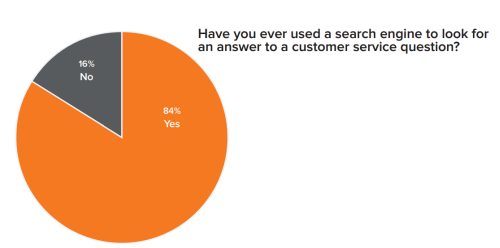 But once that is done, notice how old preferences then reassert themselves. As we stated at the outset, live voice remains the channel to beat in many sectors.
But once that is done, notice how old preferences then reassert themselves. As we stated at the outset, live voice remains the channel to beat in many sectors.
One of the intriguing questions here is whether we are destined to always have live voice at the centre of our channel mix? To be more precise, is this being forced on customers or does it reflect the real demand?
Certainly there is wide selection of channels in play as this 2013 global call centre study from Deloitte shows.
At face value, this would suggest a more balanced channel mix is being used. However once we revert to actual usage figures and customer preferences, the old preference can be clearly seen. Here are a couple of insights reflecting how customers judge channel effectiveness. ContactBabel’s 2013 studies of US and UK channel usage (The Inner Circle Guide to Multi-channel Customer Contact) show the domination of voice in both markets (US is blue, UK is green)
We can see this same pattern when reverting to an outside-in viewpoint. This insight shows how customer perception drives channel use. Here the Parature study shows live voice to be twice as popular when ‘speed of response’ becomes a factor. Note how email languishes as a result.
Yet interestingly a B2B customer of cloud vendor NewVoiceMedia managed to transform the very same mix by simply providing his customers with a two hour SLA for email instead of the more common 24+ hour response time. 40% of his voice traffic migrated as a result! Is this a one-off situation or something others can learn from? Maybe the answer is that the performance of the channel drives use. In other words, customers are pragmatic and will use whatever works.
If that seems obvious then it should be no surprise to learn from the same eDigitalResearch report that Chat takes top honours for customer satisfaction. Why? For one thing it’s perceived average response time is under a minute. And it also delivers other benefits. Here is a great observation by Helen Burt, this time in her role as parent.
“Live chat is brilliant because it allows you to multitask – In my case this means not worrying if my toddler is destroying the house in the background. No need for “mummy’s talking darling!”
Ideas To Take Away
Multi-channel behaviour is part of how digital consumers go about their business. They expect you to offer choice and consistency. Speed matters. All the research suggests organisations have much ground to cover before this is common place.
From an infrastructure perspective this means point solutions are now impediments to the right customer experience. Unified queuing which enables one set of business rules and one set of reports is the only way to design both flexible and consistent multi-channel experiences. The good news story for those ready to move on is that cloud solutions deliver a low risk route of discovery.
However the tech is really a downstream decision and should be based on a prior in depth view of what customers want in relation to the task they are trying to achieve with you. So the immediate task you face is how to develop the capability to build and maintain that detailed insight.
One thing is for sure. The traditional quest for channel migration is mainly fool’s gold. Customers choose based on what they see as their best interests not yours. So your only chance of success is to think ‘outside-in’. This is not to say you cannot encourage new customer behaviour. You can if you end up offering something better for the customer. But until then, the evidence says that live voice remains the most trusted way to get what you need as a customer.
Maybe it’s time to change mindset.
Photo Credit: Rodrigo Kore via Flickr cc


